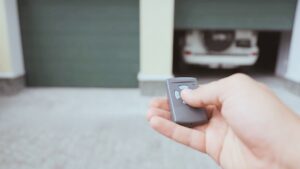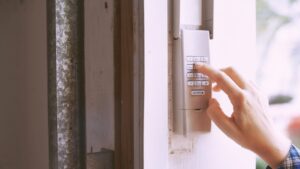Are you one of the many homeowners struggling with an imbalanced garage door? If so, you’re not alone!
Is your garage door refusing to cooperate? It might be a balancing issue if it’s not working as intended. Balancing a garage door is integral to keeping it in good working order, but it can seem daunting if you’re new to this process.
Balancing a garage door doesn’t have to be daunting, even if you’re not tech-savvy. In fact, with just four simple steps, you can restore your garage door’s balance and keep it functioning smoothly for years to come.
So, let’s dive into this step-by-step guide on how to balance a garage door and regain control of your garage.
Signs You Have Garage Door Balancing Issue
It’s normal to experience some common issues with your garage door. But balance is one of the most important—and often overlooked—problems.
A balanced garage door will open and close smoothly, while an imbalanced one can cause a lot of frustration and inconvenience if it’s not working as intended.
Before taking the plunge and balancing your garage door, it’s essential to recognize the signs of balance issues. Common symptoms include:
- Uneven movement when opening or closing: When the balance is off, your garage door will move unevenly when being opened or closed. It may appear to jerk and struggle to complete a cycle without support.
- Shaking or shuddering when in motion: The balance may be off if your garage door is shaking or vibrating when in motion. This usually occurs due to uneven weight distribution on the door.
- An abrupt stop during operation: That’s right! Balance issues could be the culprit if your garage door stops abruptly during operation. That’s because an imbalanced door will struggle to carry its weight and may pause unexpectedly when in motion.
- Loud noises resulting from balance-related issues: One final sign of balance problems is loud noises from the garage door. When balance is off, strange sounds can occur as the motor struggles to maintain control over an unevenly weighted door.
If you’ve identified any of these problems, it’s time to take action and restore balance to your garage door! We have the solution for you later in this guide – so keep reading!
What Causes an Unbalanced Garage Door?
Balance is when a garage door has the same weight on either side of the balance point, which means that the extension springs balance out the right and left sides of your door.
A few different things could cause an unbalanced garage door:
- It could be because one side of the door has more weight than the other, or there may not be enough tension in the springs that help balance it out.
- Another reason could be that some parts are worn out or broken and need to be tightened or replaced.
If you think your garage door is unbalanced, you should call an expert to look at it and balance it out. They will check all the parts and ensure everything is in good working order before they balance it back up again, so you don’t have any problems with it later on!
How to Perform a Garage Door Balance Test
So, you’ve confirmed the signs that indicate you have an imbalanced garage door, understood what might cause balance issues, and are now looking to call in the experts for assistance.
But before you do so, you can take one simple and vital step—a garage door balance test. This will provide valuable insight into the balance of your garage door, helping you prepare for a professional service call if required.
Here’s how to perform a garage door balance test:
1. Ensure the Garage is Securely Closed from the Inside
This is as simple as it sounds—ensure the garage door is securely closed before you begin.
2. Disengage the Garage Door Opener
To balance your garage door, you will need to open and close it manually. To do this, disengage the opener by pulling on the red emergency release cord at its base. This will allow you to open and close the door manually.
3. Manually Open and Close the Garage Door

After disengaging the garage door opener, try to open and close the garage door manually. Grasp the door with both hands and steady it while opening it, so it stays in proper balance.
If the balance is off, you will feel a difference in weight distribution on either side of the balance point. Doing this manually is essential to getting a true sense of balance.
These three steps should provide you with enough information to determine whether the balance is off or not. If the balance is indeed off, call the experts for professional help!
Connect With A Garage Expert
Connect with local experts, Compare quotes, Get the best price.
How to Balance a Garage Door with a Torsion Spring
The torsion spring is the most common spring system used in garage doors. Its job is to balance the garage door’s weight and make it easy to open and close. If your torsion spring is out of balance. In that case, you’ll need to adjust it in the following steps:
DIY Disclaimer
Before attempting any work on your garage door, it is important to remember that the torsion spring system of a garage door is under a significant amount of tension and that attempting to work on it without the proper training or tools can be extremely dangerous.
If you are unsure how to properly adjust a torsion spring’s tension properly, it is best to contact a professional.
Step 1: Switch Off the Opener Power

Turn off the power from the garage door’s motor, and unplug it. This will ensure that no harm comes to you while adjusting the balance of your door.
Step 2: Check the Torsion Springs
After turning off the power, you should check for errors with the torsion springs.
- Firstly, check for rust accumulation and corrosion on the spring. Rust can signify that the spring is weakening, so looking for any signs of corrosion or rust buildup is essential.
- Next, inspect the balance of the spring. You can do this by performing a balance test. To do this, lift the garage door to a three-quarter position and let go – if it stays in place, your spring is balanced correctly. If it falls or slides, then your balance needs adjusting.
Step 3: Adjust the Torsion Springs Tension When Needed
Balancing torsion springs is not a one-time job and should be checked and adjusted. If you’ve recently moved house or had any work done on your garage door, check the balance of the torsion springs again.
It’s also important to note that other factors, such as worn-out components or broken hardware, can cause balance issues.
To help prevent balance issues, we recommend getting your garage door serviced and inspected regularly. This is of utmost importance, as the National Electronic Injury Surveillance System (NEISS) reports that an estimated 2,500 people are crushed by garage doors in America annually, and another 7,500 suffer pinched injuries.
Step 4: Perform the Final Balance Test
Once you’ve finished making any adjustments, it is important to test the door again to ensure it is properly balanced.
Repeat this process until the balance is even and the garage door can stay in place when lifted three-quarters of the way up.
This is an indicator that the garage door is properly balanced.
Connect With A Garage Expert
Connect with local experts, Compare quotes, Get the best price.
How to Balance a Garage Door with Extension Springs
Unlike torsion springs, extension springs balance the garage door’s weight by stretching and contracting.
If you believe your extension springs are out of balance, you’ll need to adjust them by:
Step 1: Switching Off the Opener Power
As with balance tests for torsion springs, switching off all power sources is also essential before attempting to balance extension springs. The main reason for turning off the power is to avoid being electrocuted while working on the balance.
Step 2: Check and Release Spring Tension

You’ll need to check the balance of your extension springs by relieving their tension. To make it easier to use the extension springs, you can move the hook to a different hole or loosen and adjust the length of the clamp. Both choices will allow you to obtain your desired outcome effectively and rapidly.
Step 3: Place Clamps And Adjust the Springs
After releasing the tension, you can balance your garage door by placing clamps on both sides of the extension spring.
Clamps serve as a way to hold the torsion spring in place while you are trying to adjust it. Place clamps on either side of the spring. Afterward, use your winding bars and turnbuckles to tighten or loosen the springs.
If they’re too loose, tighten them up by turning both bars clockwise, and if they’re too tight, loosen them by turning them counterclockwise. It is important to note that the springs must be equal in tension to keep your door balanced.
Step 4: Perform the Final Test
Once the balance is achieved, perform another balance test to double-check the results. If all is well, your garage door should now be balanced correctly!
Balancing your garage door is vital to maintaining its functionality and safety. If done correctly, it can help you get the most out of your garage door and prevent any potential accidents.
How Much Does Garage Door Balancing Cost?
The average cost of repairing a balance issue can range from $100 to $300. The cost can vary depending on your garage door balance problem and any other parts and repairs that need to be done.
Here is a breakdown of some of the potential costs you may encounter when hiring a professional or attempting a DIY repair:
| Repair Option | Parts | Labor | Total Cost |
| Hiring a Professional | $50-$300 | $50-150 | $100-$2000+ |
| DIY Repair | $50-$300 | $0 | $50-$500+ |
We recommend consulting a professional garage door technician to get an accurate estimate, so you don’t spend more than necessary.
Final Thoughts
We know it can be a handful trying to do the garage door balance test yourself, but trust us—it’s not as difficult as it seems! Moreover, regular balance checks can save money and help maintain your garage door’s performance.
Hiring a professional is a great way to balance your garage door and check for any potential repairs that need to be done. So, contact us if you need help!




